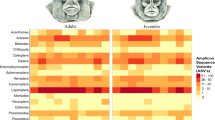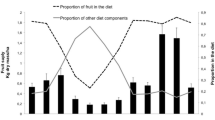Abstract
I present data regarding the diet and feeding ecology of a spider monkey community at Lago Caiman in northeastern Bolivia. The community was highly frugivorous, only consuming significant amounts of folivorous material during times of relative fruit resource scarcity. Spider monkeys fed on parts of 86 plant species, but the majority of the diet comprised a few dominant fleshy fruit species that were available at temporally distinct periods across the year. Accordingly, I identified candidate keystone resources for the region and discuss the results with reference to previous studies on Ateles and the importance of considering keystone fruit resources in the management of forestry concessions.
Similar content being viewed by others
References
Altmann, J. (1974). Observational study of behavior: Sampling methods. Behavior, 48: 1–41.
Cant, J. G. H. (1980). What limits primates?Primates 21: 538–544.
Castellanos, H. G. (1995). Feeding behavior of Ateles belzebuth E. Geoffroy 1806 (Cebidae: Atelinae) in Tawadu Forest southern Venezuela. Ph.D. Thesis. University of Exeter, U.K.
Chapman, C. (1987). Flexibility in diets of three species of Costa Rican primates. Folia Primatol. 49: 90–105.
Chapman, C. (1990). Association patterns of spider monkeys: The influence of ecology and sex on social organization. Behav. Ecol. Sociobiol. 26: 409–414.
Chapman, C. A., Chapman, L. J., Wrangham, R., Hunt, K., Gebo, D., and Gardner, L. (1992). Estimators of fruit abundance of tropical trees. Biotropica 24: 527–531.
Chapman, C. A., Wrangham, R. W., and Chapman, L. J. (1995). Ecological constraints on group size: An analysis of spider monkey and chimpanzee subgroups. Behav. Ecol. Sociobiol. 36: 59–70.
Chivers, D. J., and Hladik, C. M. (1980). Morphology of the gastrointestinal tract in primates: Comparisons with other mammals in relation to diet. J. Morph. 166: 337–386.
Coehlo, A. M., Bramblett, C. A., Quick, L. A., and Bramblett, S. S. (1976). Resource availability and population density in primates: A socio-bioenergetic analysis of the energy budgets of Guatemalan howler and spider monkeys. Primates 17: 63–80.
Dittus, W. P. J. (1977). The social regulation of population density and age-sex distribution in the toque monkey. Behaviour 63: 281–322.
Dunbar, R. I. M. (1976). Some aspects of research design and their implications in the observational study of behavior. Behavior 58: 78–98.
Dunbar, R. I. M. (1987). Demography and reproduction. In Smuts, B. B., Cheney, D. L., Seyfarth, R. M., Wrangham, R. W., and Struhsaker, T. T. (eds.), Primate Societies, Univ. of Chicago Press. Chicago, London.
Dunbar, R. I. M. (1988). Primate social systems, Croom Helm, London and Sydney.
Esau, K. (1977). Anatomy of Seed Plants, John Wiley and Sons, Canada.
Foster, R. B. (1982). Famine on Barro Colorado Island. In Leigh, E. G., Rand, A. S., and Windsor, D. M. (eds.), The Ecology of a Tropical Forest: Seasonal Rhythms and Longterm Changes, Smithsonian Institution Press, Washington, D. C.
Gautier-Hion, A., Duplantier, J.-M., Quris, R., Feer, F., Sourd, C., Decoux, J.-P., Dubost, G., Emmons, L., Erard, C., Hecketsweiler, P., Moungazi, A., Roussilhon, C., and Thiollay, J. -M. (1985). Fruit characters as a basis of fruit choice and seed dispersal in a tropical forest vertebrate community. Oecologia 65: 324–337.
Gentry, A. H., and Terborgh, J. (1990). Composition and dynamics of the Cocha Cashu “mature” floodplain forest. In Gentry, A.H. (ed.), Four Neotropical Rainforests, Yale University Press, New Haven and London.
Goodall, J. (1986). The chimpanzees of Gombe—Patterns of behavior, Belknap Harvard Press, London.
Karesh, W. B., Wallace, R. B., Painter, R. L. E., Rumiz, D. I., Braselton, W. E., Dierenfeld, E. S., and Puche, H. (1998). Immobilization and health assessment of free-ranging black spider monkeys (Ateles paniscus chamek). Am. J. Primatol. 44: 107–123.
Killeen, T. J., García, E., and Beck, S. G. (1993). Guía de árboles de Bolivia, La Paz, Herbario Nacional de Bolivia and Missouri Botanical Garden.
Kinnaird, M. F. (1992). Phenology of flowering and fruiting of an East African riverine forest ecosystem. Biotropica 24: 187–194.
Klein, L. L., and Klein, D. J. (1977). Feeding behaviour of the Columbian spider monkey. In Clutton-Brock, T. H. (ed.), Primate Ecology, New York Academic Press, NY.
Koenig, A., Borries, C., Chalise, M. K., and Winkler, P. (1997). Ecology, nutrition, and timing of reproductive events in an Asian primate, the Hanuman langur (Presbytis entellus). J. Zool. Lond. 243: 215–235.
Krebs, C. (1989). Ecological methodology, Harper and Row, New York.
Laska, M., Carrera Sanchez, E., Rodriguez Rivera, J. A., and Rodríguez, Luna E. (1996). Gustatory thresholds for food-associated sugars in the spider monkey (Ateles geoffroyi). Am. J. Primatol. 39: 189–193.
Maisels, F., Gautier-Hion, A., and Gautier, J.-P. (1994). Diets of two sympatric colobines in Zaire: More evidence on seed-eating in forests on poor soils. Int. J. Primatol. 15: 681–701.
McFarland Symington, M. (1988a). Food competition and foraging party size in the black spider monkey (Ateles paniscus chamek). Behavior 105: 117–134.
McFarland Symington, M. (1988b). Demography, ranging patterns, and activity budgets of black spider monkeys (Ateles paniscus chamek) in the Manu National Park, Peru. Am. J. Primatol. 15: 45–67.
Milton, K. (1982). Dietary quality and demographic regulation in a howler monkey population. In Leigh, E. G., Rand, A. S., and Windsor, D. M. (eds.), The Ecology of a Tropical Forest: Seasonal Rhythms and Longterm Changes, Smithsonian Institution Press, Washington, DC.
Neville, M. K, Glander, K. E., Braza, F., and Rylands, A. B. (1988). The howling monkeys, genus Alouatta. In Mittermeier, R. A., Rylands, A. B., Coimbra-Filho, A., and Fonseca, G. A. B. (eds.), Ecology and behavior of Neotropical primates, WWF, Washington, DC.
Nunes, A. (1995). Foraging and ranging patterns in white-bellied spider monkeys. Folia Primatol 65: 85–99.
Nunes, A. (1998). Diet and feeding ecology of Ateles belzebuth belzebuth at Maraca Ecological Station, Roraima, Brazil. Folia Primatol 69: 61–76.
Oates, J. F. (1987). Food distribution and foraging behavior. In Smuts, B. B., Cheney, D. L., Seyfarth, R. M., Wrangham, R. W., and Struhsaker, T. T. (eds.), Primate Societies, Univ. of Chicago Press. Chicago, London.
Painter, R. L. E. (1998). Gardeners of the forest: Plant-animal interactions in a Neotropical forest ungulate community. Ph.D. Thesis, University of Liverpool, Liverpool.
Peres, C. A. (1994). Primate responses to phenological changes in an Amazonian Terra Firme forest. Biotropica 26: 98–112.
Peres, C. A. (1997). Effects of habitat quality and hunting pressure on arboreal folivore densities in Neotropical forests: A case study of howler monkeys (Alouatta spp.). Folia Primatol 68: 199–222.
PLUS-CORDECRUZ. (1994). Plan de Uso de Suelos Total del Departamento de Santa Cruz, Cordecruz, Santa Cruz, Bolivia.
Richard, A. (1970). A comparative study of the activity patterns and behavior of Alouatta villosa and Ateles geoffroyi. Folia Primatol. 12: 241–263.
van Roosmalen, M. G. M. (1985). Habitat preferences, diet, feeding strategy, and social organization of the black spider monkey (Ateles p. paniscus Linnaeus, 1758) in Surinam. Acta Amazonica 15: 1–238.
van Roosmalen, M. G. M., and Klein, L. L. (1988). The spider monkeys, Genus Ateles. In Mittermeier, R. A., Rylands, A. B., Coimbra-Filho, A., and Fonseca, G. A. B. (eds.), Ecology and behavior of Neotropical primates, WWF, Washington, DC.
Rosenberger, A. L., and Strier, K. B. (1989). Adaptive radiation of the ateline primates. J. Human. Evol. 18: 717–750.
van Schaik, C. P. (1986). Phenological changes in a Sumatran rain forest. J. Trop. Ecol. 2: 327–347.
Strier, K. B. (1992). Atelinae adaptations: Behavioral strategies and ecological constraints. Am. J. Phys. Anthropol. 88: 515–524.
Synott, T. J. (1979). A manual of permanent plot procedures for tropical rainforests. Tropical Forestry Paper No.14, Unit of Tropical Silviculture, Commonwealth Forestry Institute, University of Oxford.
Terborgh, J. (1983). Five New World Primates—A Study in Comparative Ecology, Princeton University Press, Princeton, New Jersey.
Terborgh, J. (1986a). Keystone plant resources in the tropical forest. In Soule, M. E. (ed.), Conservation Biology: The Science of Scarcity and Diversity, Sinauer, Sunderland, Mass.
Terborgh, J. (1986b). Conserving New World primates: Present problems and future solutions. In Else J. G., and Lee, P. C. (eds.), Primate Ecology and Conservation, Cambridge University Press.
Wallace, R. B. (1998). The behavioral ecology of black spider monkeys in north-eastern Bolivia. Ph.D. Thesis, University of Liverpool, Liverpool, U.K.
Wallace, R. B., and Painter, R. L. E. (1997). Modelando el efecto de la tala selectiva sobre la fauna silvestre:—Una posible metodología para establecer pautas en el manejo forestal sostenible? In Fang, T. G., Bodmer, R. E., Aquino, R., and Valqui, M. H. (eds.), Manejo de Fauna Silvestre en la Amazonia, UNAP, University Florida, UNDP/GEF, Instituto de Ecologia. La Paz, Bolivia.
Wallace, R. B., and Painter, R. L. E. (2002). Phenological patterns in a Southern Amazonian tropical forest: Implications for sustainable management. Forest Ecol. Manag.160: 19–33.
Wallace, R. B., Painter, R. L. E., and Taber, A. B. (1998). Primate diversity, habitat preferences and population density estimates in Noel Kempff Mercado National Park, Santa Cruz, Bolivia. Am. J. Primatol. 46: 197–211.
Wallace, R. B., Painter, R. L. E., Rumiz, D. I., and Taber, A. B. (2000). Primate diversity, distribution and relative abundances in the Rios Blanco Y Negro Wildlife Reserve, Santa Cruz Department, Bolivia. Neotropical Primates 8(1): 24–28.
White, L. J. T. (1994). Patterns of fruit-fall phenology in the Lope Reserve, Gabon. J. Trop. Ecol. 10: 289–312.
Wiens, J. A. (1977). On competition and variable environments. American Scientist 65: 590–597.
Author information
Authors and Affiliations
Corresponding author
Rights and permissions
About this article
Cite this article
Wallace, R.B. Seasonal Variations in Diet and Foraging Behavior of Ateles chamek in a Southern Amazonian Tropical Forest. Int J Primatol 26, 1053–1075 (2005). https://doi.org/10.1007/s10764-005-6458-4
Received:
Accepted:
Issue Date:
DOI: https://doi.org/10.1007/s10764-005-6458-4




